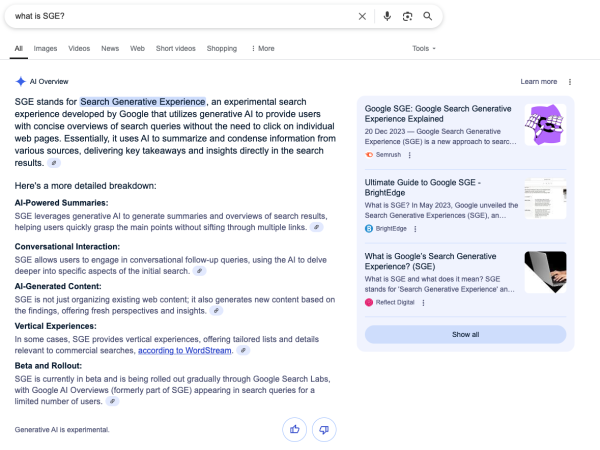Have you ever clicked on a website where the links are broken, you can’t navigate certain parts of the website on your mobile or the page is loading really slow? Integrating search experience optimisation (SXO) techniques can help with this.
If you’re new to SXO, or you just want more information, this article will cover the important elements you need to know to get started. From understanding the relationship between SEO, SXO and SGE to understanding the benefits of using SXO in your marketing strategy, this article will cover it all.
What Is Search Experience Optimisation?
Search experience optimisation is the practice of combining SEO and user experience (UX) tactics to create a seamless experience for users from the moment they land on your website. Unlike traditional SEO, which focuses primarily on driving traffic, SXO aims to ensure that visitors have a positive experience and are more likely to convert.
The Importance Of Using SEO, SXO & SGE Together
Traditional SEO: Focuses on improving your website’s visibility in search engine results. This can be done by optimising your product pages, writing great page titles and meta descriptions and creating high-quality content that drives backlinks. While these methods are effective in driving traffic, they don’t always consider the user’s journey once they land on your site.
Search Experience Optimisation: Considers factors that could impact the users experience on your site, looking at factors like site speed, mobile friendliness, content quality and user engagement. By improving these elements, SXO ensures that visitors not only find your site, but are also more engaged, leading to higher conversion rates.
Search Generative Experience (SGE): Leverages AI and machine learning to provide even more personalised and interactive search results. This approach aims to predict user intent more accurately and deliver immediate, relevant results, enhancing the overall search experience.
For an eCommerce store, you’ll want to ensure your site ranks as high as possible in the search engine results page. SXO takes this one step further by ensuring that users have a smooth experience on your site. From navigation to streamlining the checkout process, SXO ensures that users are more likely to convert once they land on your site.
Ultimately, optimising your website to enhance user experience will help with usability, rankings and visibility, making it extremely important to optimise your website for SEO, SXO and SGE.
Related: SEO tips for fast ranking.

The Benefits Of SXO
When users have a positive experience on your site, they are more likely to return, recommend your site to others and become loyal customers. If you’re considering using SXO strategies on your website, here are some benefits that make SXO a worthwhile strategy for online businesses:
- More Targeted Traffic: Focusing on the right keywords and user intent means you can resonate with what your target audience wants to see.
- Improved Competitiveness: A solid SXO strategy makes you stand out, boosts your click-through rates and gives visitors a good reason to buy from you.
- Higher Conversion Rates: The smoother the customer journey, the higher the chances that customers will convert.
- Improved Brand Reputation & Trust: A reliable and credible website leads to more sales, as well as enhanced search engine rankings.
- Customer Retention: The better the UX, the more likely your customers are to buy from you again, as well as encouraging their friends and family to buy from you.
- Future-Proof Search Results: SXO strategies build long-term value for users, ensuring that your website is covered against algorithm changes.
- Enhanced Customer Data: Monitoring your customer journey gives you a wealth of insights that can help improve your marketing performance.
Key Components Of Effective SXO
Successful SXO requires a combination of several key components, each contributing to a better user experience and higher search rankings.
Content Quality & Relevance
Providing quality content is the cornerstone for any successful marketing strategy, and it’s only gotten more and more important due to Google’s quality content updates.
It involves creating engaging, informative and relevant content that meets the needs and expectations of your audience. This includes using appropriate keywords, structuring content for readability and providing valuable insights that keep users coming back for more.
User Engagement & Interaction
User engagement is crucial for SXO. By encouraging users to share and comment on your content, you will keep users on your site for longer, but it will also signal to search engines that your site is valuable and relevant.
Technical SEO & Site Performance
As previously mentioned, technical SEO, such as site speed, mobile optimisation and secure connections (HTTPS), plays a significant role in SXO. By ensuring that your site is fast-loading and mobile-friendly, you can significantly improve UX.
Ultimately, search engine optimisation is likely to lead to higher engagement and lower bounce rates, as well as being favoured by search engines for offering a seamless UX across all devices.
CTA’s are one of the most important elements of ad copy, specifically for headings. Depending on the platform (Google Ads, Facebook Ads, etc), headings and descriptions are limited in how many characters can be used.
Use persuasive language that elicits a sense of urgency, such as ‘Buy Online Today’ or ‘Shop Now’. By strategically using effective CTA’s throughout your ad copy, you can increase the chances of your audience converting and engaging with your ad.
Why Choose Proof3 For Your Marketing Needs?
At Proof3, we have a specialised team of SEO and CRO specialists. With 25 years of combined experience in helping eCommerce businesses, we have a comprehensive understanding of the challenges and opportunities in digital marketing. Using this knowledge, we will work together to create customised strategies and suggest changes that are proven to drive results.
Ready to take your marketing to the next level?
If you’re looking to improve your search experience optimisation and drive better results from your digital marketing efforts, drop us a line. Our team of specialists are on hand to help you achieve your SEO and CRO goals and take your online performance to the next level.
About the author
Henry Jones
Share this post
Read more

